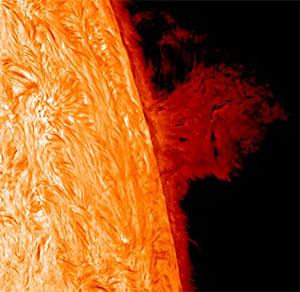

Plasma Physics
One of the sun's biggest mysteries is why its corona (the upper level of the sun's atmosphere) is so hot. The sun's core is a searing ~27 million degrees Fahrenheit (F), but by the time that heat reaches the sun's surface, it cools off to a mere ~10,000 degrees F, only to again heat up to more than 18 million degrees F in the corona, above the surface. This isn't just about understanding the sun, though. The corona is made of plasma (a hot, electrically charged gas and one of the four fundamental states of matter), and many believe the answer has to do with the physics of how these plasmas work.
No surprise, NSF-funded researchers are looking into this issue and many other plasma physics issues that surround our sun.
Featured video: When Nature Strikes -- Science of Natural Hazards: Space Weather
Space weather has the potential to interfere with everything from satellite communications to electrical power. Atmospheric scientists and geospace researchers are studying the behavior of the sun to develop warnings of solar storms that may be coming Earthâs way. "When Nature Strikes" was produced by NBC Learn in partnership with NSF.
RELATED NEWS
- It's Hot...Super Hot (NSF Discovery, November 12, 2013)
- Plasma Jets Are Suspect in Solar Mystery (NSF News Release, January 6, 2011)
- Distant Star's Sound Waves Reveal Cycle Similar to Sun (NSF News Release, August 26, 2010)
- More to Solar Cycle Than Sunspots (NSF News Release, September 17, 2009)
- Connections among Solar Cycle, Stratosphere and Ocean Discovered (NSF News Release, August 27, 2009)
- Scientists Create First Comprehensive Computer Model of Sunspots (NSF News Release, June 18, 2009)
RESOURCES
- Springtime Night Lights: Finding the Aurora (NSF Discovery, March 31, 2015)
- Trailer for "Solar Superstorms," a co-production of Spitz Creative Media, the National Center for Supercomputing Applications' Advanced Visualization Lab, and Thomas Lucas Productions, Inc., in association with the Fiske Planetarium at the University of Colorado (Boulder). The project was made possible with support from the Commonwealth of Pennsylvania and the Pennsylvania Film Office, and with funding by NSF.
- Spray-on Solar Panels (NSF Science Nation Video Series, February 14, 2011)
Any opinions, findings, conclusions or recommendations presented in this material are only those of the presenter grantee/researcher, author, or agency employee; and do not necessarily reflect the views of the National Science Foundation.
